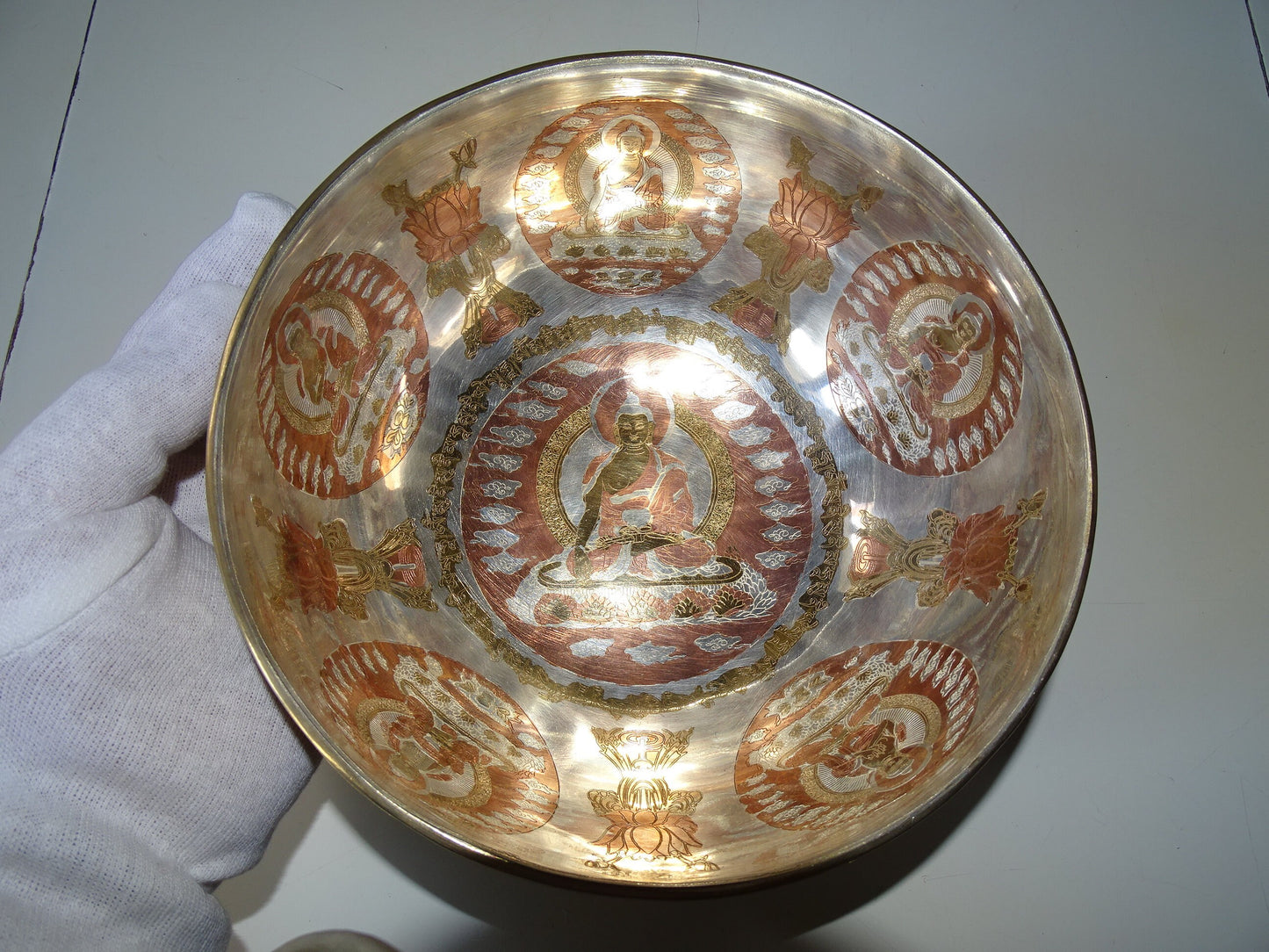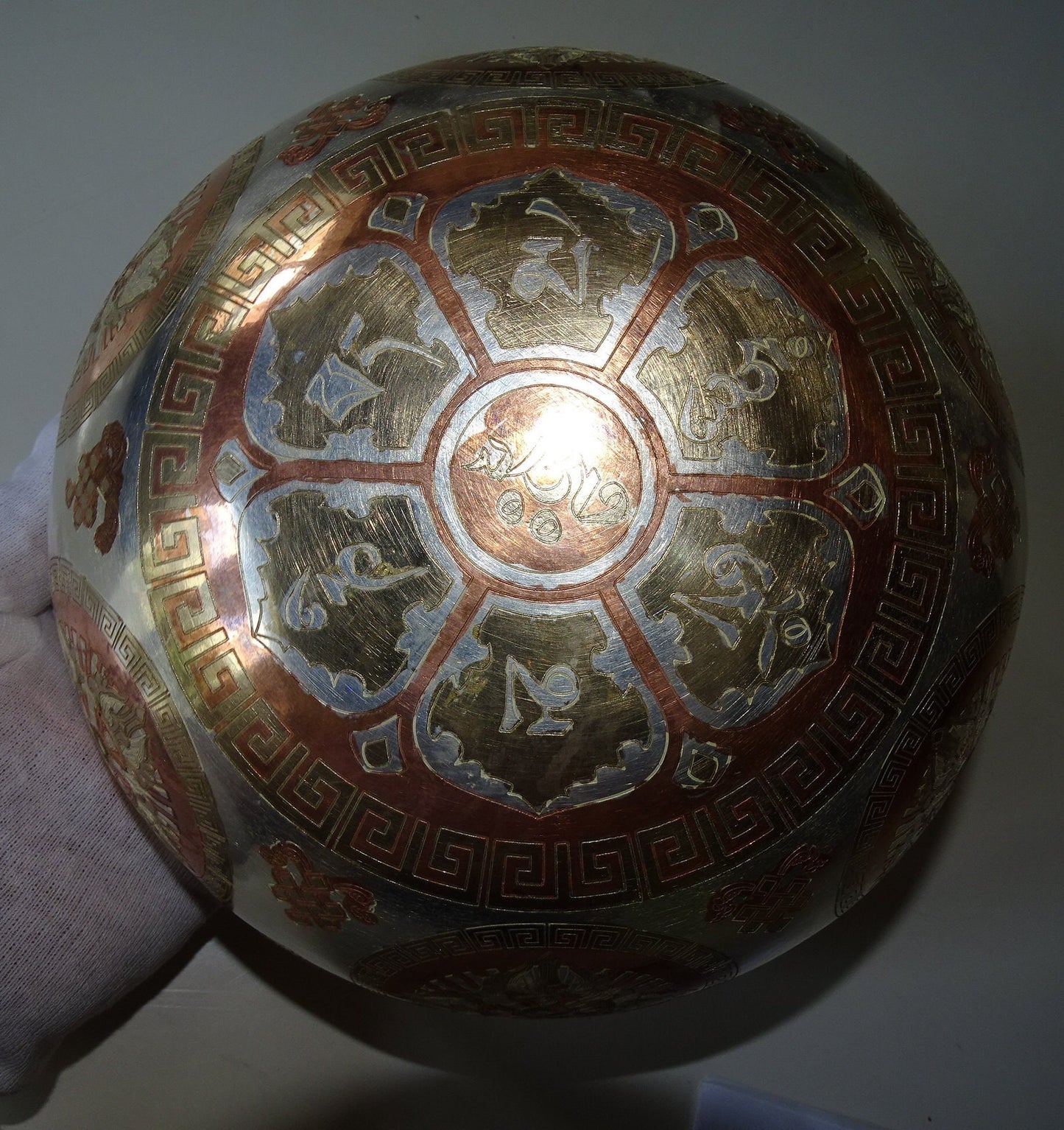Silver-plated singing bowl, available in 4 sizes: 20, 23, 25, or 30 cm, weighing from 1100 to 2800 grams. Decorated with Buddha engravings and auspicious symbols! Sold with a mallet and white glove!
Silver-plated singing bowl, available in 4 sizes: 20, 23, 25, or 30 cm, weighing from 1100 to 2800 grams. Decorated with Buddha engravings and auspicious symbols! Sold with a mallet and white glove!
Couldn't load pickup availability
About the product:
- Made in Nepal!
- Made of bronze and 'Silver plated'!
- Details of auspicious (good luck) symbols, such as the double Dorje, the lotus and the endless knot.
- Sold with a pair of white gloves to avoid marking the bowl and a suitable mallet!
- Each silver-plated singing bowl is adorned with engraved images of Shakyamuni Buddha and the five Dhyani Buddhas.
The bowl is further decorated with auspicious symbols such as the double dorje, the lotus and the endless knot, as well as the compassionate mantra “Om Mani Pad Me Hum”.
The silver plating is applied through a careful electrochemical process, enveloping each bowl in a lustrous layer of pure silver that enriches its tone and vibration.
- Benefits of Silver plating, with its high density and excellent acoustic properties, enhances the natural purity of a singing bowl's sound, creating a clear and uplifting sound.
The bowl's reflective surface not only adds to its aesthetic appeal, but can also amplify the energy it radiates, making it a powerful tool for meditation and sound healing.
- Equivalence of notes and frequencies:
- DO4 /C = 257 Hz
- RE4 / D = 289 Hz
- MI4 / E = 324 Hz
- FA4 / F = 343 Hz
- SOL4 / G = 385 Hz
- A3 / A = 216 Hz
- SI3 / B = 244 Hz
- The percentages of metals, the diameter and the thickness of the different bowls provide the specific sound and harmonics of each singing bowl.
Each bowl is therefore unique.
Please note: All our handmade singing bowls are sorted by weight. The diameter mentioned is an approximate guideline, so you have a general idea of the bowl's width.
- Information about the process of hammering Tibetan singing bowls: The process of hammering singing bowls is entirely done by hand.
Each singing bowl is hammered following a series of procedures that will give the bowl the perfect shape.
During the manufacturing phase, different metals that make up the bowl are melted in a furnace (copper, tin, iron, lead, gold and silver) depending on the type of bowl desired, such as bronze bowls or those of the seven metals.
The molten metal is then poured into a mold to obtain a metal disc of the desired size and thickness.
At this stage, the metal disc is modeled after being weighed and measured very precisely and then is classified according to the type of bowl to come.
As for the actual hammering process, 4 or 5 discs are stacked on top of each other and then heated until they become incandescent.
The formed glowing metal disc is then hammered by skilled craftsmen until the metal is no longer hot; then it is heated again and hammered again.
These two operations, heating and hammering, continue until the desired shape and size are achieved (which explains why hammered singing bowls can vary by a few centimeters from one another). When hammering the bowls, the metal disc should be beaten while it is still hot, because it is more flexible.
Once cooled, in fact, the metal loses its flexibility and becomes increasingly brittle, thus risking cracks that would occur if struck. Once the desired shape is achieved, the stages of manufacturing the bowl itself begin.
Each bowl is brought to the desired shape and size, repeating the heating and hammering phase if necessary.
Once the desired shape and size are achieved, the bowl is hammered to perfection. Individual bowls are then chiseled and finished inside and out.
Attention please!
Share
















